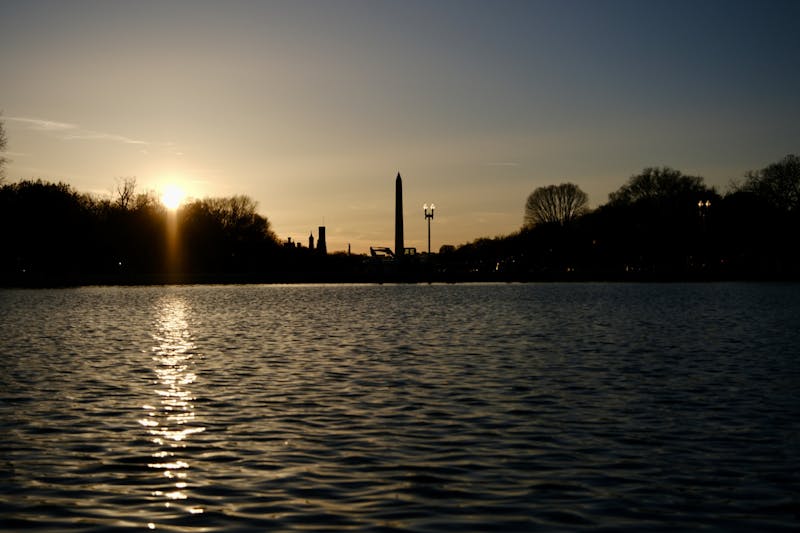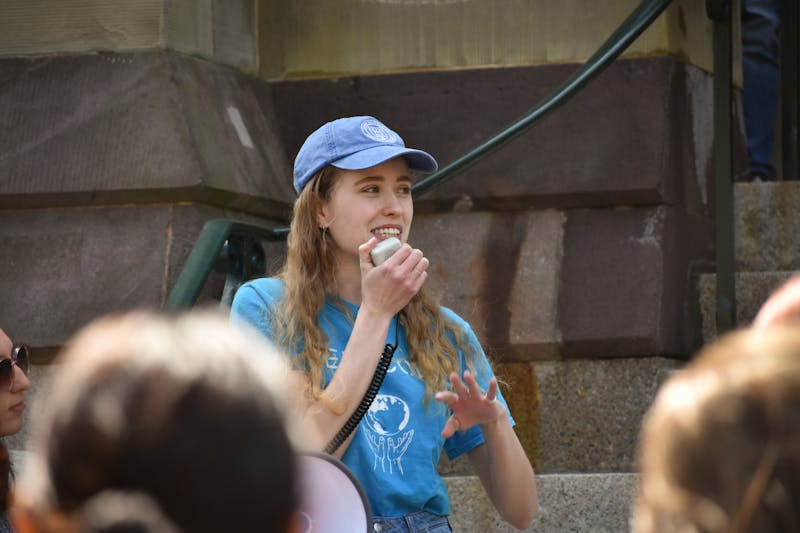Tired of the rancid, cramped metropolis of London. Weary of the religious persecution that dominated England. Sick of an aged, arthritic Europe. Burning for a change. The Quaker settlement would occupy a one and a half mile-wide plot of land set between the Delaware and Schuylkill rivers, and would be known as Penn's Green Country Town. The name would later be changed -- to Philadelphia. The settlement, originally planned as a farming community, would have five public spaces, or parks, set aside both for recreational use and as a meeting place for the community. Each park would be square, taking up one and a half city blocks and measuring 500-600 feet on each side. There would be four squares, one in each corner of the settlement. A fifth would be situated in the very middle. Northeast, northwest, southeast, southwest and center square would provide the city with a geographic center. Over the next 100 years the city grew exponentially, and by the middle of the eighteenth century, Philadelphia was the largest metropolitan center in the colonies, and the second largest in the British Empire. All five parks changed as the city grew, each developing its own history and character. In 1825, each park was named for an historical figure key to the city's past. Of those five parks, four of them have not been built upon to this day. The fifth has has been home to City Hall for the past century. ashington Square is located between 6th and 7th on Walnut Street. During the Revolutionary War, the area became a burial ground and Potter's Field for fallen soldiers from both armies. Over 2,000 soldiers and civilians are buried just below the surface of the park. Burials continued in the square after the war. "Washington Square was a stranger's burial ground," said Independence National Historical Park Historian Coxey Toogood. "It was also used for slaves and freemen. In 1793 it was used for mass burial for the poor who died during an epidemic of yellow fever." In the early nineteenth century, the square was opened up again for public use. There was some discussion of keeping city government in the older sections of the city by building City Hall in Washington Square. Instead, City Hall was built in Centre Square in order to put the government at the city's hub. A statue of George Washington was dedicated in the square in 1954, and remains there to this day. A stone casket at Washington's feet represents the tomb of the unknown soldier, a memorial to Revolutionary War heroes. An eternal flame that commemorates the death of tens of thousands of colonial soldiers burns in front of the tomb. Today, Washington Square remains a public park. Two paths meet by a fountain in the middle of the square, with Washington's monument on the west side of the park. Civic organizations in the area are currently petitioning to add the square to Independence National Park, which ends on 6th and Walnut. "This would be an interesting development," said Toogood. "That would take [Washington Square] off of the city role. It would get better maintenance because the city is always poor." ranklin Square is located between 6th and 7th on Race Street, just north of the Vine Street Expressway. Like Washington Square, Franklin Square served as a colonial burial ground. During the Revolutionary War it doubled as an ammunition storage base. Isamu Noguchi's controversial sculpture, "Bolt of lightning?A memorial to Benjamin Franklin," is located on the eastern side of 6th street adjacent to the square. The sculpture sits on a green that was part of Franklin Square before the Ben Franklin Bridge divided it. The sculpture, originally conceived in 1933, depicts a key being hit by a 23-foot tall bolt of lightning. The blueprints of the sculpture, well before their time, were stored and forgotten in the Fairmount Park archives for almost fifty years. In 1979, they were discovered and in 1984, the sculpture was dedicated in its current location. In the last several years, Franklin Square has fallen on hard times. Homeless men and women began living in the park. "Franklin Square has turned into somewhat of a scary place," said Toogood. "It's always a little scary." Residents of the surrounding neighborhood wanted the vagrants out, and in the past years have resorted to such criminal tactics as setting park benches on fire. The homeless in Franklin Square were recently evicted by Philadelphia Police. Franklin Square is currently home to a baseball field and playground in addition to the sculpture. ogan Circle can be found between 17th and 18th on Race Street. Although still technically Logan Square, the area has primarily been a traffic circle since 1919 when it became part of the Benjamin Franklin Parkway. Logan Square was named after James Logan, Secretary of the Governor's council during the turn of the eighteenth century. During the eighteenth century, Logan Square was used primarily as a gallows and burial ground. Its use was modified during the Civil War and World War I, when Logan Square was used as a fairgrounds to raise money for sick and wounded soldiers. Swann Memorial Fountain lies inside the circle. Finished in 1924, the fountain features a bronze male, female, and young child surrounded by frogs and turtles. The figures represent the three rivers that Philadelphia is built around -- the man is the Delaware, the woman the Schuylkill, and the child the Wisshickon. Today, Logan Circle sits in the shadow of other architectural masterpieces. It is more or less equidistant from the Art Museum on one side and City Hall on the other, and lies practically in the shadow of the Franklin Institute. Aside from its artistic value, the circle regularly plays host to street fairs during the spring and summer months. ittenhouse Square can be found between 17th and 18th on Walnut Street. Rittenhouse Square was named after David Rittenhouse, an astronomer native to North Philadelphia. Beginning in the eighteenth century, the area around the square served as a recreational park space surrounded by wealthy homes which later became hotels, office buildings and apartment complexes. "Rittenhouse is probably the most fashionable of the squares," said Philadelphia Historic Commission Director Richard Tyler. "From the time of its beginning it had a fashionable [feeling]." Rittenhouse Square is the scene of many public outdoor speeches held in the city, as well as an annual huge 'clothesline' art gallery. "The clothesline exhibit is an open air gallery," said Philadelphia Visitors Center Historian Jane White. "Artists pin up their art every spring. More than 2,000 works of fine art [are exhibited]." In December, Rittenhouse Square becomes home to Philadelphia's largest Christmas tree. ity Hall Square, formerly Centre Square, is located at the intersection of Broad and Market streets. There is some evidence to support the belief that Benjamin Franklin conducted his famous 1754 kite experiment in Centre Square. The experiment is commonly said to have been conducted in the commons near the city. At the time, Centre Square was the town commons, separated from the city by several blocks of forest. Local Revolutionary War troops were drilled in Centre Square commons. In 1781, 6,000 men representing two divisions of the French army were encamped there. In 1800, the city of Philadelphia began plans to build a municipal waterworks that would tap underground streams. The pumps were furnished by Nicholas Roosevelt, great uncle of President Theodore Roosevelt. The Centre Square waterworks were in operation from 1801 through 1822. In 1837, a movement began to erect a city hall, but work on the actual site did not begin until 1872. Construction lasted 30 years, but by the turn of the century, Philadelphia had what is arguably the greatest work of architecture in the city's history. City Hall would have been the world's tallest manmade structure, but by its completion, it had been surpassed by the Eiffel Tower and the Washington Monument. City Hall rises 547 feet high, with a 36 foot tall statue of William Penn on its tower. City Hall's four central pavilions represent four continental themes: European in the north, African in the south, Asian in the east, and American in the west. There are over 250 sculptures mixed throughout the interior and exterior of the building. From the time that City Hall was completed, Philadelphia held a "gentlemen's agreement" not to build anything taller than the statue of William Penn. That agreement was finally discarded in 1986. Today, the center of the five squares in William Penn's Green Country Town is towered over by modern skyscrapers.
The Daily Pennsylvanian is an independent, student-run newspaper. Please consider making a donation to support the coverage that shapes the University. Your generosity ensures a future of strong journalism at Penn.
DonatePlease note All comments are eligible for publication in The Daily Pennsylvanian.







